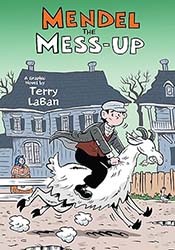In this evocative story, a young girl named Sarah accidentally breaks her bubbe’s treasured glass bowl. Not only is she forgiven for this unintentional act, but fragments of the bowl end up making their way around the world and eventually return to Sarah’s great-granddaughter. The narrative demonstrates both the joys of sharing and the bonds that connect generations.
Throughout the book, Fedele’s striking use of color intensifies the simplicity of the text. Whether “lost in the churning waves” of the sea, or almost winding up in a piece of fish stew, the blue shards sparkle on the page. Fedele’s first picture shows the bowl filled with bright yellow lemons, a brightness that tempts Sarah to reach up and touch the glass while her mother’s back is turned. It’s an impulse with which children will identify. The brown earth tone of Sarah’s dress, the deep copper color of the pots, and the amber curtains stand in contrast to the whiteness of the kitchen fixtures.
Pieces of blue glass travel from Coney Island to Florida, Venezuela, and Tel Aviv. A mother finds one while washing clothes outdoors. A man picks one up on the beach and offers it to his daughter as a reminder of the home they are about to leave. A girl from Israel, who feels lonely as she settles in New York, gives the broken glass as a gift to the one classmate who has shown her kindness. In each scenario, imagination and empathy imbue an ordinary, broken object with meaning. The author avoids sentimentality by telling stories that, just like the glass, appear only in fragments — fragments that have the potential to become something more.
This beautiful story incorporates both tangible and emotional experience with a sense of balance and calm.
Emily Schneider writes about literature, feminism, and culture for Tablet, The Forward, The Horn Book, and other publications, and writes about children’s books on her blog. She has a Ph.D. in Romance Languages and Literatures.





